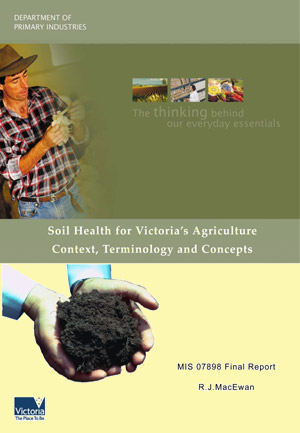|
|
This report has been prepared to provide a baseline for soil health work in DPI with respect to the use of terminology, a general understanding of soil health within agro‐ecosystems and some frameworks that can be used in future work. Soil health is an essential aspect of environmental health as it supports a range of ecosystem services. This is a complex topic and a single report can do little more than indicate useful sources of literature and an outline to provide context. There is a wealth of literature on soil health and soil quality but terminology and definitions sometimes differ and therefore waylay the unwary reader. Some aspects have been dealt with in more depth than others but I have attempted to provide a balanced and comprehensive overview of soil health from a scientific point of view. The focus is particularly soil health for agriculture, but the implications of soil health for environmental health and for provision of ecosystem services are also discussed. The international context for soil health has been summarised with key references provided. Priorities for soil health are presented through a general framework that is used in landscape research and decision making. Author : R. J. MacEwan Conclusions :
Acknowledgements : The Agriculture pision of DPI Victoria is acknowledged for funding this project. Additional funding was received from DSE, North Central Catchment Management Authority and West Gippsland Catchment Management Authority to support other aspects of soil health review or research associated with this project. Several scientists in DPI contributed directly to the project through advice, analysis or written contributions. Pauline Mele (DPI Rutherglen) is acknowledged for contributing a soil biology perspective on soil health and James Nuttall (DPI Horsham) for his review of remote sensing as a surrogate for plant and soil health. Nathan Heath (DPI Wodonga) is acknowledged for providing a case study for soil extension based on experiences in North East Victoria. Keith Reynard (DPI Bendigo) carried out a review of data for soil and land in the North Central CMA region. Joanne McNeill and Doug Crawford compiled and analysed soil and land data for the West Gippsland CMA region, using the Land Use Impact Model (LUIM) to develop a regional soil erosion management plan. Doug Crawford (DPI Werribee) and Nathan Robinson (DPI Bendigo) carried out a review of DPI soil datasets and this is provided as a separate report. Jim Allinson (consultant) and Stuart Boucher are acknowledged for their contribution in preparing a review and report for DSE on the case for investment in soil health. Other DPI staff; Michael Crawford, Mark Imhof, Mark Allaway, Kimberley Dripps, Melva Ryan and the participants in DPI soil health workshops provided direct and indirect help through activities associated with the development of DPIs strategic framework for Soil Health. Dr Samantha Baxter from Reading University (UK) was supported by this project for a visit to DPI for three weeks and made a significant contribution to the analysis of data and supervision of staff in the use of geostatistics. Steve Williams (DPI Bendigo) is acknowledged for his significant contribution to discussions about data, information and knowledge management. DSE staff; Adam Hood, Shayne Annett, Kim Lowe, Matt White and David Cummings are acknowledged for discussions and advice regarding DSEs interest in soil health. During the course of this project, team members were involved in DPI workshops related to policy and project development, with CMAs in the development of soil health strategies and in presentations at public and scientific forums on soil health. Related projects have also helped with formulation of some of the ideas presented in this and the associated reports. In particular, the ORL Our Landscape project (MIS 05188) through which the framework attributed to Carl Steinitz has been applied, and the GRDC subsoil constraints project (MIS 07541) which entailed related data analysis for soils in South East Australia especially for functional aspects of subsoils. |
|

